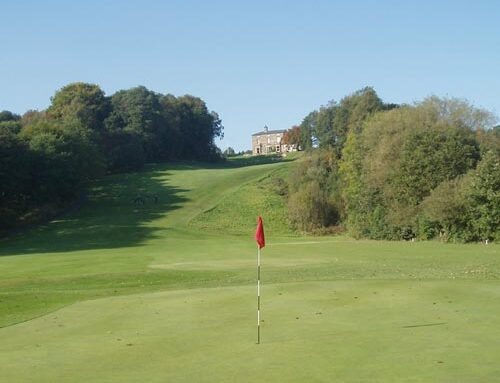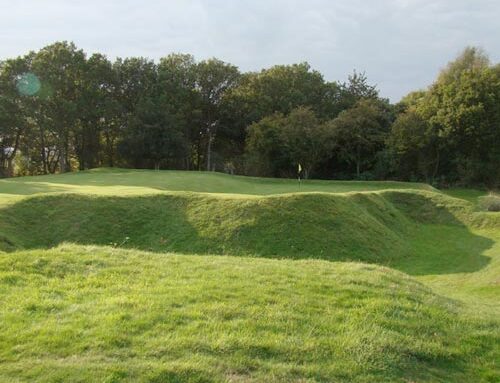Silloth on Solway Golf Club
Cumbria, England
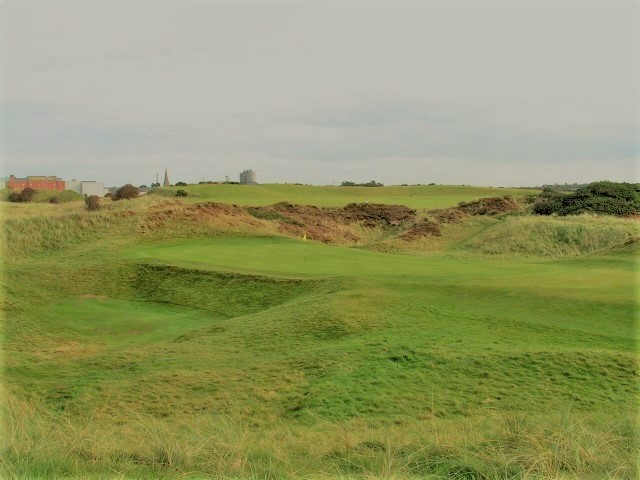
One of the game’s great green complexes, the 4th resembles the 1st at Pine Valley Golf Club with a fairway that runs onto the green that features sharp drop-offs left and right.
Established in 1892, Silloth on Solway originally opened as a par of 4,750 yards. Though many of the original playing corridors are still in use, the initial holes laid out by David Grant do not bear much resemblance to today’s course. For instance, the first two holes occupied the ground of today’s 380 yard opener, but were one shot holes of approximately 200 yards each.
Principal credit for today’s stirring links course belongs to Willie Park, Jr., who designed Sunningdale Old and his own favourite, Huntercombe in England, as well as several world class courses in North America headlined by the revered Maidstone Club on Long Island. Alister MacKenzie, who lived several hours away in Leeds, also lent a hand at the third green and fourth tee.
The town of Silloth is no longer the thriving resort that it was in Victorian times. Nonetheless, golfers are still thrilled to head here just as both these master architects must surely have been over a century ago. Afterall, the property before them constitutes something near the ideal: stunning location set along the Cumbria coastline, panoramic views of Scotland to the north, humpy bumpy landforms, gorse and heather, and the ever present wind off the Solway Firth. What more could you ask for?!
Today’s routing is generally out and back in nature with the ninth and tenth holes being the farthest points from the clubhouse. However, the property is wider than other out and back routings such as Royal Troon and The Old Course at St. Andrews. At its widest point, the property’s breadth accommodates the seventeenth, second, third, fourth and fifth holes – and that’s with the third running straight toward the coastline.
With such width available, the architects had greater freedom to route holes so that the player rarely encounters the wind in the same direction for more than two holes. The drawback normally associated with an out and back routing is that one nine can play relatively easy compared to the other. That is not true at Silloth – the best holes are evenly spread throughout the course and the course is engaging in all winds.
Apart from the sheer beauty of this part of Cumbria, the lasting impression is made by the quality and variety of the green sites. Three are located in their own dells (e.g. the first, seventh, and seventeenth), its most famous green site is located at the highest point on the course on an exposed knob (the thirteenth) while the one prior is enclosed left and behind by a thick bank of gorse. Some of the smaller greens are heavily bunkered (e.g. the ninth and sixteenth) and five greens (e.g. the first, fourth, seventh, thirteenth and seventeenth) are bunkerless though well defended by natural features.
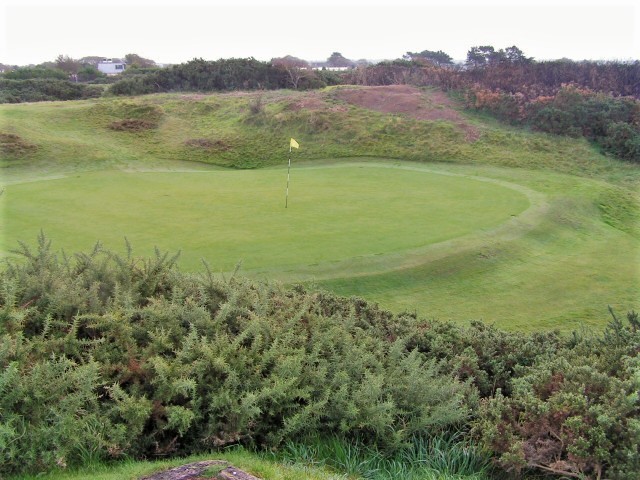
The variety in placement of the green sites creates much of the course’s lasting interest. Pictured above is the first green in a dell which gathers balls in from well back in the fairway.
Given the firmness of the turf and the wind, when coupled with the imaginative green sites, this is genuine links golf of a high order.
Holes to Note
Third hole, 370 yards, Criffel; The golfer climbs a steel ladder to see when the fairway is clear and then blindly fires his tee ball between two sand hills. The fairway curves left toward a green benched into the far hillside. The shorter way home off the tee (down the left) must confront heather and bent while the longer way home (down the right) leaves the golfer with a more awkward stance and a greater distance to cover.
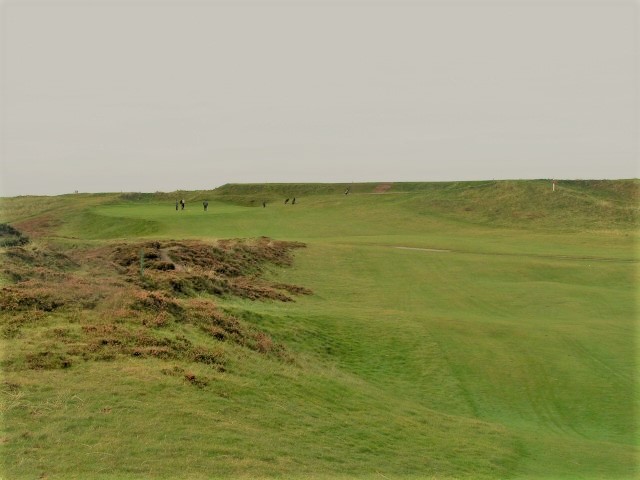
The thick heather down the left needs to be avoided off the tee.
Fourth hole, 370 yards, The Mill; After the second blind tee ball in the first four holes (i.e. real links golf!), the golfer is faced with one of the game’s great approach shots. The fairway feeds directly onto a bunkerless green site whereby one foot off the green to the left is a ten foot drop and one foot off the right of the green is a seven foot drop. At 38 paces, the green is the longest on the course and shots played to the back hole locations require tremendous skill and nerves. The great local female golfer Cecil Leitch no doubt relished this hole as a way to showcase her tremendous talents. Many a golfer has played ping pong across the narrow green, reminding some of the dangerous eleventh at the Country Club of Charleston.
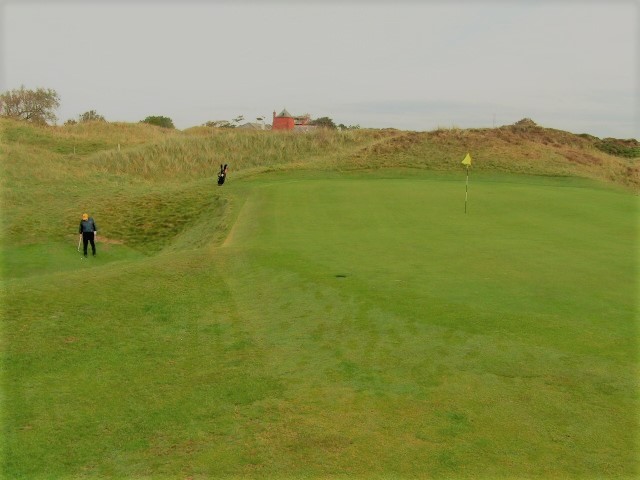
This man’s approach was pulled slightly left, leaving him with an awkward stance to a green some ten feet above. Though the recovery was well played from the slight downhill lie …
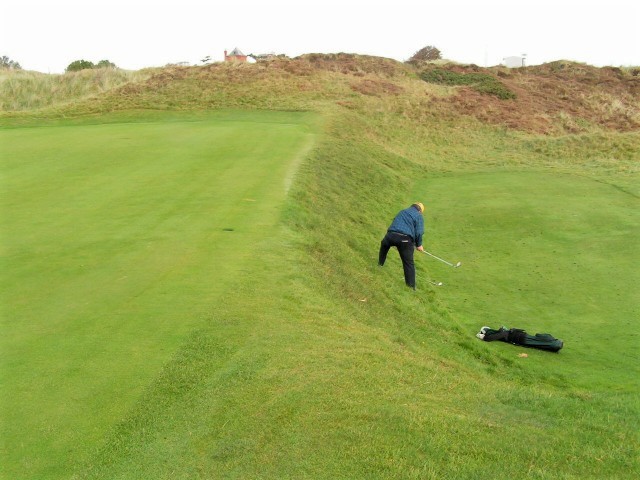
…the golfer’s ball didn’t quite hold the putting surface and trickled down the right bank of the green. A quick (and easy!) ‘6’ was carded on this 370 yarder from just a slightly pulled approach.
Fifth hole, 520 yards, Solway; The placement of the tees in the dunes creates an appealing and strategic diagonal carry to a fairway that parallels the coastline of the Solway Firth.

The fifth tee offers a tempting diagonal carry that can bring the green within reach for the stronger golfer. One readily imagines how the glorious beauty of this part of the world is fully revealed on sunny days.
Sixth hole, 200 yards, Natterjack; The first of an exceptional set of one shot holes, the sixth plays downhill twenty feet to a green guarded left and right by fronting wing bunkers which are distinctly in play when a) the hole is downwind and the only way to stay on the green is to land one’s tee ball between them or b) the hole is into the wind and the golfer balloons his tee ball from the elevated tee and the wind gobbles it up and deposits it into one of the fronting bunkers.
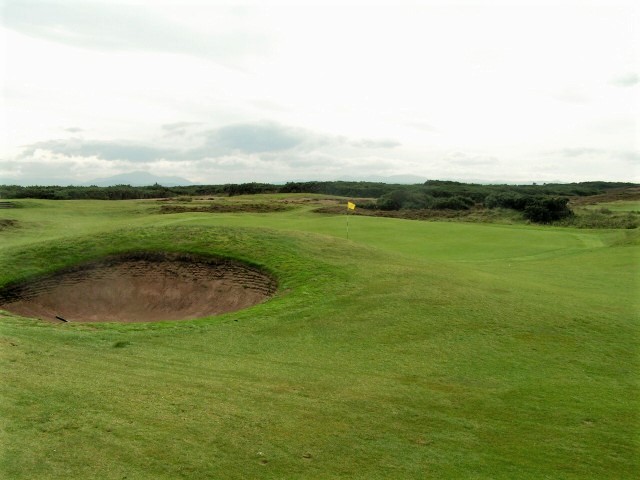
Played from well above the putting green, the 6th tee ball needs to avoid fronting bunkers.
Seventh hole, 425 yards, Battery; The pressure is on to hit a long and true tee ball as the second shot must scale a twenty foot ridge to a green tucked in a dell. Common with many other Silloth green complexes, the interior contours are good without being exceptional. However, the surrounds of the green are of exception and when taken together, the green sites at Silloth create great short game interest.
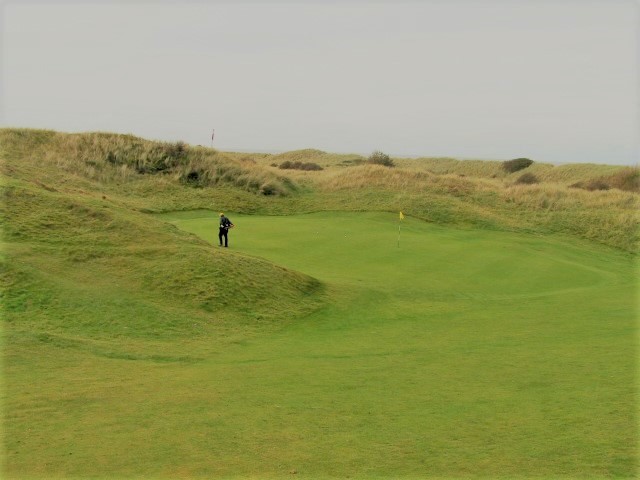
Though bunkerless, the 7th green complex doesn’t lack defenses.
Silloth on Solway Golf Club
Cumbria, England
Ninth hole, 145 yards, The Manx; This short one shotter shares similarities with the infamous Postage Stamp hole at Royal Troon two hours north up the motorway. The putting surface is long but narrow and any tee ball missed right kicks sharply away toward a nest of three bunkers six paces off and below the putting surface. From below the putting surface, the golfer is (unfortunately!) in the ideal position to practice several recovery shots before seeing his ball finally settle on the green. The author observed one such occurrence in a tight match where two attempted recovery shots landed within a foot of the putting surface only to trickle back into the same bunker. The resulting hissy fit spoke to the maddening challenges of links golf in general (maddening in the sense that the golfer may not realize where the real trouble is until it is too late) and of the merits of this well designed hole in particular.
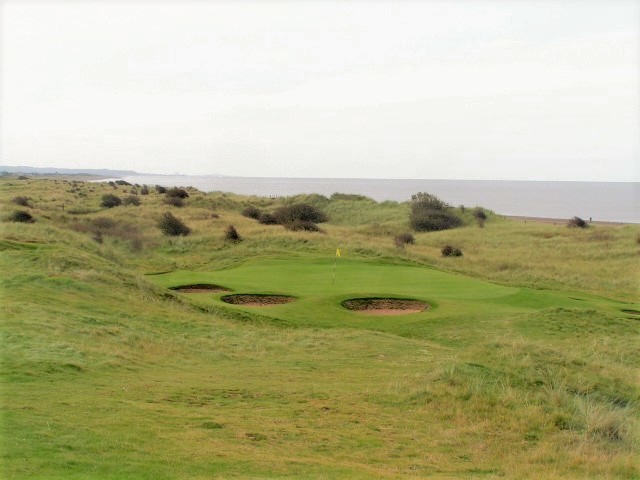
The view from the tee is deceiving as it suggests that ‘the smart miss’ is anywhere but short left. In fact, with the sharp fall off to the right, short left leaves the easiest bogey.
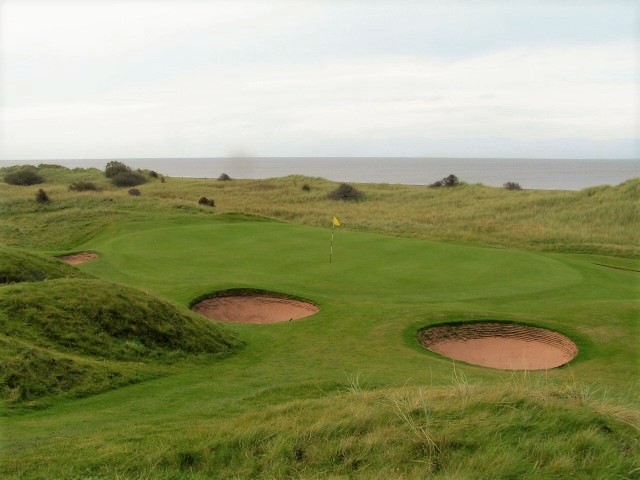
This view from closer ahead shows the 9th’s small putting surface, made all the more elusive by the ever present wind.
Twelfth hole, 205 yards, Heather Bank; As the name implies, heather is a dominant feature on this one shotter as it wraps around the left and back of the green. Thus, many a tee ball from those familiar with the course comes up short and right, leaving a tricky up and down but at least nothing worse than a bogey. It isn’t the most dramatic hole but it benefits from the architects having left well enough alone.

The attractive one shot twelfth with a bank of heather dangerously close to the back left of the green.
Thirteenth hole, 510 yards, Hogs Back; A superb, one-of-a-kind hole that exemplifies one of the accepted definitions of a classic three shotter, namely each shot gets progressively more exacting. The drive is over flat terrain and the golfer is likely to find one of the few level stances on the course, which is a good thing as the second must quickly climb uphill between a gully in two dunes. As its name implies, the second higher portion of the fairway is hog’s back in nature and shrugs off any but the straightest of shots. The green itself is on an exposed knob and falls away on all sides.Though not long in length, the thirteenth is full of character with a wide range of scores often seen within each group.
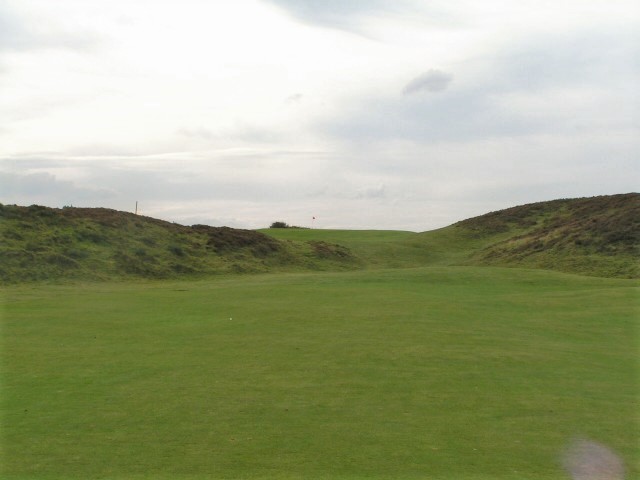
The tee ball pictured above was ideally played and leaves the golfer around 220 yards for his second into this three shotter.
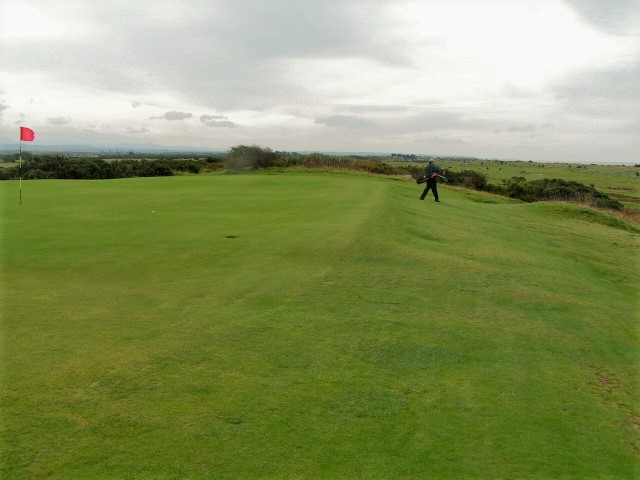
The 13th green is the most exposed point on the course. The green tilts from left to right, and the sight of a golfer walking off the green in search of his approach is a common one.
Fourteenth hole, 510 yards; Mark Rowlinson suggests that this hole would be much better known if not for the fame of the preceding three shotter. A central obstacle in the form of a tall dune falls approximately 380 yards from the tee and divides the fairway. Its significance depends on the wind but in general, if the golfer has found the fairway off the tee, carrying the dune should not be too difficult and a birdie might be in reach. However, finding the heather off the tee often leads to laying up shy of the dune and the resulting blind approach from 150 yards tilts the advantage to the course. The merits of central obstacles and hazards cannot be overstated as a) they are always in play and b) force the golfer to make decisions. Sculpted-out fairways with hazards to the sides lend themselves to dull golf. The design of Silloth on Solway is the antithesis of that, with the golfer always wondering what challenge he’ll face next.
Sixteenth hole, 200 yards, The Mount; The far dune was leveled off to make room for a small putting surface which hardly seems big enough at just 21 paces deep to hold a tee ball in any kind of crosswind. Veteran players often elect to drill their tee balls low and have them run up the six foot bank onto the putting surface. With bunkers left and right, the hole is exacting, regardless of what method the golfer attempts.

Any tee ball that finds the putting surface is well played indeed.
Seventeenth hole, 495 yards, Duffers; No friend to duffers, the penultimate hole features a forced carry but once again, the hole’s neatest aspect is its green complex, this time of the punchbowl variety with out of bounds to the right.
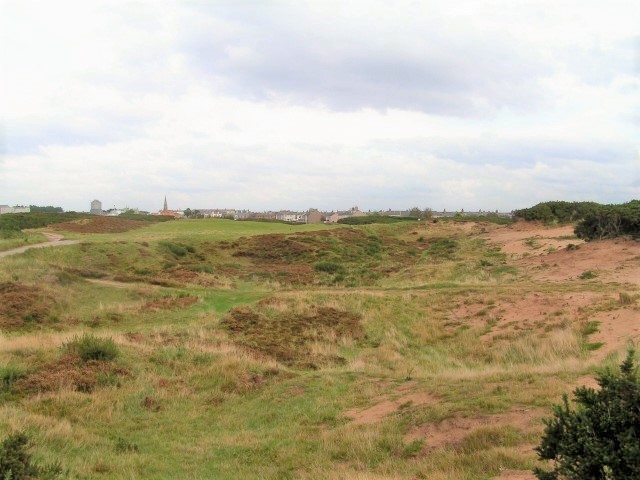
The tee ball must carry this dramatic mix of broken ground, heather, gorse, bent and sand.
After the round, the author witnessed a conversation among golf course enthusiasts that essentially went as follows: ‘Can you believe how good the set of par three holes are? It is certainly the best I’ve seen on our trip’ which was followed by ‘That may be true but the strength of Silloth on Solway surely lies with its par four holes.’ In turn that observation was met with, ‘Though you both may be right, the par five 13th is the single best hole on the course and the par five that follows might be the most underrated hole.’ Such is the golf on offer at Silloth on Solway.
With no obvious weaknesses and plenty of merit, the author can think of no reason why Silloth on Solway isn’t as equally well known around the world as such remote links as Cruden Bay and Machrihanish. The three courses share many similarities. Just as some of the game’s greatest architects gave Cruden Bay and Machrihanish their green complexes, the same holds true here. Golfers always relish the opportunity to invent shots around interesting green sites and in large part for this reason, these courses remain forever engaging to play.
Throw in the beauty of Silloth with the Cumbrian mountains in the distance to the south and views of Scotland to the north and the golfer may be forgiven if he hopes to keep Silloth his own secret for just a few more years.
The End



![Minchinhampton (Old) [2016]](https://golfclubatlas.com/wp-content/uploads/2018/09/Minchinhampton-500x383.jpg)
![St. Enodoc (Church) [2017]](https://golfclubatlas.com/wp-content/uploads/2017/11/St.-Enodoc-500x383.jpg)

![Sunningdale (Old) [2014]](https://golfclubatlas.com/wp-content/uploads/2017/11/Sunningdale-Old-Course-500x383.jpg)
